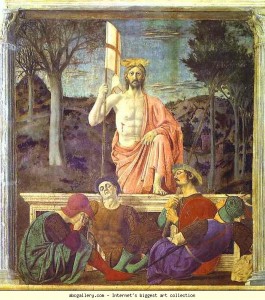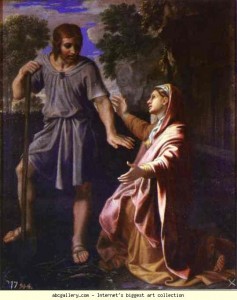Frequently sceptics argue that the resurrection accounts found in the New Testament cannot be taken seriously because they are full of contradictions. Reading the accounts again recently, it struck me how overstated this claim is. From the outset, it has to be said that even if differences between the accounts could not be reconciled, it still wouldn’t be a good objection to the historical case for the resurrection in any case[i]. That case hinges on various facts which can be established on historical grounds and which in many cases are widely accepted by believer and unbeliever alike. In other contexts where independent testimonial evidence is being considered, differences on minor matters are to be expected and can help to show that the accounts are indeed independent. As the noted historical Jesus scholar E. P. Sanders pointed in his dismissal of the idea that the Gospel accounts were the result of a deception, “a calculated deception should have produced greater unanimity”.
 Be that as it may, it is still worth considering the alleged contradictions. The goal here is not to address every issue that has been raised, but just to take a few as examples. The Gospels differ in terms of the women who went to the tomb on the Sunday morning. Matthew says it was ‘Mary Magdalene and the other Mary’, Mark that it was ‘Mary Magdalene, Mary the mother of James, and Salome’, Luke that it was ‘Mary Magdalene, Joanna, Mary the mother of James, and the others’, and John that it was Mary Magdalene. A contradiction? Hardly. In fact, there’s complete agreement that Mary Magdalene went to the tomb. If John said it was only Mary Magdalene, then there would be a contradiction, but he doesn’t. Why does he not mention the others? It seems likely he’s just being selective (and if we’re going to question his reliability on that ground we’re going to have to question every historical source on every topic) since he’s going to focus on Mary’s seeing the risen Lord. The other three Gospels mention another Mary and two of them that she was the mother of James, so no contradiction there either. Mark and Luke mention others too, so provided we permit the authors to be selective, there’s really not much of a problem.
Be that as it may, it is still worth considering the alleged contradictions. The goal here is not to address every issue that has been raised, but just to take a few as examples. The Gospels differ in terms of the women who went to the tomb on the Sunday morning. Matthew says it was ‘Mary Magdalene and the other Mary’, Mark that it was ‘Mary Magdalene, Mary the mother of James, and Salome’, Luke that it was ‘Mary Magdalene, Joanna, Mary the mother of James, and the others’, and John that it was Mary Magdalene. A contradiction? Hardly. In fact, there’s complete agreement that Mary Magdalene went to the tomb. If John said it was only Mary Magdalene, then there would be a contradiction, but he doesn’t. Why does he not mention the others? It seems likely he’s just being selective (and if we’re going to question his reliability on that ground we’re going to have to question every historical source on every topic) since he’s going to focus on Mary’s seeing the risen Lord. The other three Gospels mention another Mary and two of them that she was the mother of James, so no contradiction there either. Mark and Luke mention others too, so provided we permit the authors to be selective, there’s really not much of a problem.
It is certainly true that the Gospels don’t give us an exact sequence of events and it is difficult to try to reconstruct what the sequence might have been, but that on its own doesn’t constitute much of a problem. Of course, out of curiosity it would be nice to know the exact sequence, but not having it certainly doesn’t amount to a contradiction. Consider the women telling the disciples and the first appearances. Matthew has the women running from the tomb to tell the disciples and meeting Jesus on the way. Mark says they fled from the tomb and ‘said nothing to anyone, because they were afraid’. Luke says they went to tell the disciples while John says that Mary Magdalene (remember that John only mentions Mary anyway) went to tell Peter and John (who then go to see for themselves) and after that she sees Jesus. Apart from Mark there is agreement that the women go to tell the disciples. Does Mark contradict these accounts? No. It seems fairly clear that all he means is that they didn’t speak to anyone on the way because they were afraid (Matthew also notes that they were ‘afraid yet filled with joy’). It is generally agreed that Mark 16:9-20 is not part of the original version of Mark’s Gospel, so the original ends rather abruptly at this point leaving us wondering what happens next (or else the original ending is missing). In fact, in Mark they were commanded by an angel (whom Mark describes as a ‘young man dressed in a white robe’) to go ‘tell his disciples and Peter’ so it seems unlikely Mark is telling us that they disobeyed this command.
 There certainly is a significant difference between John’s account, where Mary tells Peter and John and then meets Jesus, and Matthew’s account, where the women seemingly meet Jesus on the way to tell the disciples. But it is hardly a contradiction. A plausible reconciliation is that Mary left the tomb before the other women and was not with them when they met Jesus, but she returned to the tomb and met Jesus herself. In his book The Easter Enigma, John Wenham went into great detail to reconstruct a scenario along these lines. One can certainly understand why sceptics might not be convinced, but we don’t need to go along with all aspects of his account to see that there need not be any contradiction here. Note that the sceptic is making a very strong claim here: that the Resurrection accounts are contradictory. To counter that claim is not necessary to be able to establish the detailed sequence of events, but merely to show that the accounts could be compatible and that the claim of the sceptic has not been demonstrated.
There certainly is a significant difference between John’s account, where Mary tells Peter and John and then meets Jesus, and Matthew’s account, where the women seemingly meet Jesus on the way to tell the disciples. But it is hardly a contradiction. A plausible reconciliation is that Mary left the tomb before the other women and was not with them when they met Jesus, but she returned to the tomb and met Jesus herself. In his book The Easter Enigma, John Wenham went into great detail to reconstruct a scenario along these lines. One can certainly understand why sceptics might not be convinced, but we don’t need to go along with all aspects of his account to see that there need not be any contradiction here. Note that the sceptic is making a very strong claim here: that the Resurrection accounts are contradictory. To counter that claim is not necessary to be able to establish the detailed sequence of events, but merely to show that the accounts could be compatible and that the claim of the sceptic has not been demonstrated.
Finally, what about the subsequent meetings of Jesus with his disciples? Matthew records Jesus meeting the disciples in Galilee, Luke records Jesus meeting the disciples in Jerusalem and John has meetings in both. Furthermore, in Matthew and Mark the women are instructed to tell the disciples to go to Galilee where they will see Jesus. As in the earlier discussion, most of these differences can be accounted for by the authors simply selecting different events to narrate and so do not amount to contradictions since they are not claiming to give an exhaustive account of all the appearances. At first glance, Luke’s account seems to present a more serious problem, however. Jesus meets the disciples on the first Sunday evening, tells them to stay in Jerusalem (no mention of going to Galilee) and then Jesus is taken up to heaven. So Jesus’ command to stay in Jerusalem seems to contradict directly the earlier command to go to Galilee and there doesn’t appear to be any time to allow for a meeting in Galilee before Jesus’ ascension.
The question is whether there are any hints that Luke was aware of any other appearances or a longer period of time before the ascension. If we focus solely on the Gospel of Luke the answer seems to be ‘no’, but if we look at the book of Acts, which was also written by Luke and was intended as a second volume to follow on from his Gospel (see Acts 1:1), the answer is very different. There Luke claims in Acts 1:3 that Jesus ‘gave many convincing proofs that he was alive’ and that ‘he appeared to them over a period of forty days’. It is on one of these occasions that he commands them not to leave Jerusalem (Acts 1:4). It seems clear that in his Gospel, Luke as compressed all of this into a short narrative. In other words, to reiterate an earlier point, Luke has been highly selective. Although not mentioned, it is certainly consistent with Luke’s account that Jesus met the disciples in Galilee and they then returned to Jerusalem within the forty days and were instructed to stay there. There also seems to be a fairly straightforward reason why Luke doesn’t mention Galilee. Luke is setting the scene for the next part of the story. Jesus instructs them to wait in Jerusalem for the gift of the Holy Spirit, which takes place on the day of Pentecost and as a result the Christian message spreads out from Jerusalem throughout the Roman Empire. Since that is Luke’s focus in the book of Acts, the appearances in Galilee are not essential to his narrative.
So there doesn’t seem to be much of a problem. Certainly the claim that the accounts are contradictory has not been established. More importantly, there is no reason to think that the differences between the accounts undermine their credibility as historical sources[ii]; in fact such differences may well enhance their credibility! They give us very good grounds to believe that the tomb was found to be empty on the first day of the week, that the empty tomb was discovered by women including Mary Magdalene and another Mary, and that many people believed they saw Jesus alive again on multiple occasions. These facts, along with others, provide the foundation for the historical case for the belief that God raised Jesus from the dead.
[i] In 1099, during the First Crusade, the preacher and seer Peter Bartholomew voluntarily underwent ordeal by fire to verify his credentials as a prophet. According to one source he died soon after from his burns; according to another he survived the flames, and his fatal injuries were caused by mobs of his hysterical supporters. Despite the contradictions, historians know that Peter believed in his own status as a prophet (he insisted on the severest form of the trial), that he died as a result of the trial, and that he did not die immediately from his wounds.
[ii] June 10 1190 Frederick I Barbarossa attempted to cross the River Saleph on horseback. Sources disagree about what happened next. The Emperor might have slipped from his horse and drowned; he might have suffered from a heart attack and died; he might have suffered a heart attack. One thing is clear – Frederick I Barbarossa died soon after attempting to cross the River Saleph on horseback June 10 1190.
